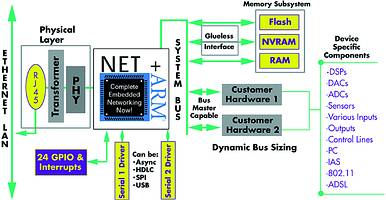32-bit networking cost-of-entry claimed to be lowered
12 February 2003
DSP, Micros & Memory
NetSilicon has released the first in a new series of small form factor 32-bit NET+ARM processors. The NS7520 processor, along NET+Works development tools, offers electronic products OEMs a low-cost option for network-enabling their products with a 33-55 MHz 177 pin BGA processor.
Graphic of NET+ARM hardware architecture
"NetSilicon is driving down the cost of network-enabling electronic products to costs comparable to 16-bit processors, but with the advantages of 32-bit performance and programmability," said Bruce Berger, general manager, NetSilicon. "NET+Works, our royalty-free development and run-time environment, enables designers to easily bring IP networking to their products. When used as the core processor in electronic products, the incremental cost of network enablement is less than US$5 for the PHY, RJ45 connector, and passives."
The NS7520 provides a means for electronics OEMs to quickly and cost-effectively give intelligent networking capability to products like industrial automation systems, building and access controls, office appliances, POS systems, medical devices, etc.
NET+Works for the NS7520 includes a full suite of development tools and networking software. Developers have a choice of NET+Works with Green Hills Multi-2000 support or MicroCross GNU tools.
Further reading:
Memory for asset tracking
Altron Arrow
DSP, Micros & Memory
The Page EEPROM, ST’s latest memory, has been designed for efficient datalogging and fast firmware upload/download in battery-operated devices.
Read more...
Engineered for high-reliability applications
Future Electronics
DSP, Micros & Memory
The MCX E series of Arm Cortex-M4F and Arm Cortex-M7 microcontrollers from NXP are engineered for demanding industrial and IoT environments.
Read more...
NXP’s development platform guide
DSP, Micros & Memory
Choosing between the FRDM i.MX 93, FRDM i.MX 91 and FRDM i.MX 91S development platforms can be intimidating, but once designers understand how each platform aligns with their application’s requirements, the decision becomes straightforward.
Read more...
XJTAG launches two new Flash programmers
ASIC Design Services
DSP, Micros & Memory
XJTAG has announced XJExpress and XJExpress-FPGA, a pair of Flash programmers perfect for development, debug and in-service applications.
Read more...
Processor offers competitive solution for advanced HMIs
Future Electronics
DSP, Micros & Memory
The new RZ/A3M microprocessor from Renesas features 128 Mbytes of fast DDR3L DRAM memory for system cost reduction, and supports
1280 x 800 px video resolution at a rate of 30 frames/s.
Read more...
ESP32-C6 achieves PSA-L2
iCorp Technologies
DSP, Micros & Memory
Espressif Systems recently announced that its ESP32-C6 microcontroller has achieved PSA Certified Level 2 (PSA-L2) security certification, making it the first RISC-V-based MCU to reach this level.
Read more...
Microprocessor with integrated NPU
Avnet Silica
DSP, Micros & Memory
The RZ/G3E from Renesas is a microprocessor integrated with quad CPU and NPU in one chip, improving power efficiency, reliability, and security.
Read more...
Nordic Semiconductor launches nRF Connect SDK Bare Metal option for nRF54L series
Avnet Silica
DSP, Micros & Memory
This is a new, RTOS-independent software solution for Bluetooth LE development, designed to ease developers’ migration from the legacy nRF5 SDK and nRF52 series to the next-generation nRF54L series.
Read more...
Dual-core support in NECTO Studio
DSP, Micros & Memory
MIKROE recently announced that version 7.3.0 of its NECTO Studio Integrated Development Environment now supports dual-core MCUs, allowing designers to program and debug each core independently.
Read more...
Post Quantum Cryptographic firmware library
DSP, Micros & Memory
The STM32 post-quantum cryptographic library enables developers to satisfy application requirements for any combination of data integrity, confidentiality, identification/authentication, and nonrepudiation.
Read more...


